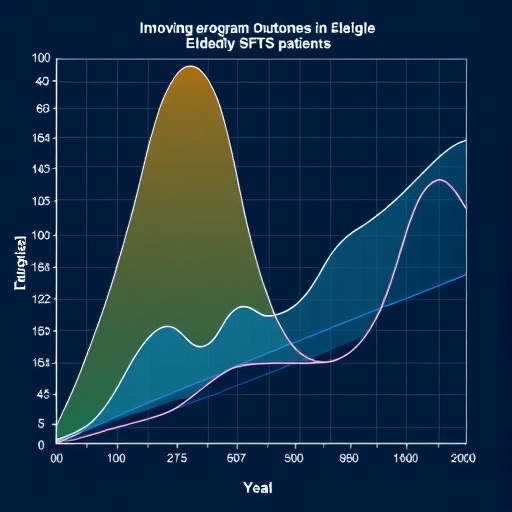In recent years, the medical community has witnessed a surge of interest in various infectious diseases, particularly those associated with significant morbidity and mortality. Among these conditions, severe fever with thrombocytopenia syndrome (SFTS) has emerged as a subject of urgent research. This viral illness, primarily caused by the SFTS virus (SFTSV), poses a particularly grave risk to the elderly demographic. With a notably high fatality rate, it is essential for health professionals to gain a deeper understanding of SFTS, especially given the mounting challenges associated with aging populations globally.
Researchers Zhang, Hu, Jiang, and colleagues have made noteworthy contributions to this field with their recent publication that introduces a novel prognostic nomogram tailored for elderly patients diagnosed with SFTS. Their study, featured in BMC Geriatrics, is poised to enhance prognostic assessments and therapeutic interventions, effectively guiding treatment approaches that are sensitive to the unique challenges faced by older patients.
SFTS, first identified in China, is transmitted predominantly through tick bites. The disease is characterized by a clinical presentation that includes high fever, thrombocytopenia, and an array of nonspecific symptoms. As the elderly are more susceptible to infections due to age-related immune decline, examining the implications of SFTS on this group is particularly crucial. Understanding the clinical markers and risk factors that contribute to poorer outcomes in older patients is vital for improving healthcare strategies.
The research team’s novel prognostic nomogram offers a quantitative method for predicting outcomes in elderly SFTS patients by incorporating various clinical parameters. This new tool aims to provide clinicians with a more accurate ability to estimate prognosis, allowing for earlier and more informed decision-making in clinical settings. By synthesizing complex data into an accessible format, the nomogram enhances the usability of prognostic predictions, which can be crucial for patient management.
Numerous studies have established that elderly patients frequently experience atypical presentations of various infections, including viral illnesses. This can mask the severity of their condition, leading to diagnostic delays and inappropriate treatment strategies. The nomogram introduced by Zhang and colleagues addresses this gap by incorporating age, comorbidities, laboratory findings, and other relevant clinical variables that specifically affect outcomes in elderly patients with SFTS.
The implications of their findings extend beyond individual patient care; these insights can inform public health strategies aimed at containing outbreaks and initiating preventive measures for high-risk populations. The development of risk stratification tools such as the nomogram is critical in the context of rising infectious disease threats fueled by environmental changes and globalization.
Moreover, the research highlights the need for heightened surveillance and research efforts focusing on the elderly as a vulnerable group susceptible to severe outcomes from infections like SFTS. Given the demographic trends indicating an increasing global population of older adults, focusing on their health needs is not only a public health imperative but also a moral one.
The data utilized in the nomogram was gathered from a comprehensive cohort analysis, incorporating a mixture of clinical records and laboratory results. As research methodology continues to evolve, harnessing data from multiple sources ensures a robust foundation for predictive modeling. This novel statistical approach can be a template for similar studies in infectious disease research, maximizing accuracy through a multifaceted analysis.
Given the complexity of SFTS and its manifestations in the elderly, the authors emphasized the importance of ongoing education for healthcare providers regarding emerging viral threats. Promoting awareness about SFTS can enhance early recognition and intervention, potentially reducing mortality rates among older adults.
The clinical community must pay attention to the results of Zhang and colleagues, particularly as the nomogram aims to bridge the gap between understanding the epidemiology of SFTS and its clinical implications for aging populations. By integrating prognostic tools into everyday clinical practice, healthcare professionals can tailor care more effectively to the needs of their elderly patients, ultimately leading to improved outcomes.
The introduction of this nomogram also raises pressing questions about the need for further study on the viral mechanisms underlying SFTSV and its interaction with the host’s immune system, particularly in older individuals whose immune responses may be impaired. Continuing research in this line is essential for developing targeted therapies, vaccines, and preventive measures against SFTS.
As the research is disseminated widely among scientific communities and healthcare practitioners, it is essential to monitor the real-world application and efficacy of this newly developed prognostic nomogram. Feedback from clinicians utilizing this tool could provide valuable insights into its performance and areas for improvement, ensuring it remains relevant to a rapidly evolving field.
In conclusion, the study presented by Zhang, Hu, Jiang, and colleagues not only signifies a key advancement in the field of geriatric infectious diseases but also serves as a call to action for further research and collaboration. These initiatives are vital in developing comprehensive strategies that prioritize the health and well-being of the elderly in a world increasingly threatened by infectious diseases like SFTS.
As researchers continue to mitigate the public health challenges associated with infectious diseases, tools such as the prognostic nomogram will play a critical role. By empowering healthcare providers with information and guidance tailored to the unique needs of older adults, we can help ensure that they receive the care they so desperately need.
Ultimately, the path forward hinges on the collective commitment of researchers, clinicians, and public health officials to prioritize the health concerns of older patients amidst the backdrop of an ever-changing epidemiological landscape. By fostering such a collaborative spirit, it is possible to achieve a substantial reduction in the burden of diseases that disproportionately impact the aging population.
As the landscape of global health evolves, the urgency of addressing viral threats like SFTS—especially among the elderly—will only grow. Continuous innovation driven by research, coupled with a compassionate approach to healthcare, will be paramount in navigating these challenges.
Subject of Research: Severe Fever with Thrombocytopenia Syndrome (SFTS) and its impact on elderly patients
Article Title: A novel prognostic nomogram for elderly patients with severe fever with thrombocytopenia syndrome
Article References:
Zhang, Z., Hu, X., Jiang, Q. et al. A novel prognostic nomogram for elderly patients with severe fever with thrombocytopenia syndrome.
BMC Geriatr 25, 784 (2025). https://doi.org/10.1186/s12877-025-06423-5
Image Credits: AI Generated
DOI: 10.1186/s12877-025-06423-5
Keywords: Severe fever with thrombocytopenia syndrome, elderly health, prognostic nomogram, infectious diseases, public health, geriatric care.
Tags: aging and immune declineBMC Geriatrics publicationhigh fatality rate SFTSinnovative nomogram for SFTSprognostic tools for infectious diseasesresearch on infectious diseasesSevere Fever with Thrombocytopenia SyndromeSFTS clinical presentationSFTS prognosis in elderly patientstherapeutic interventions for SFTStick-borne infections in elderlyviral diseases in aging populations





